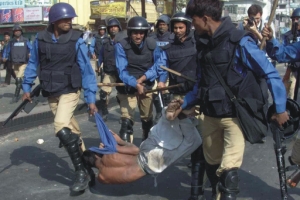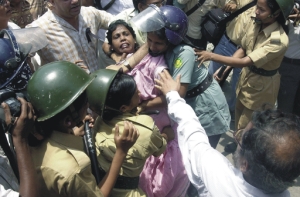Human Rights Analysis
Police behaviour in crowd management
Elyus Rahman
The attitude of the Government and its law enforcing agencies in tackling public agitation is getting violent. In this paper four incidents were chosen where crowd management by the law enforcing agencies was scrutinised, giving rise to several questions regarding lack of accountability on the means and methods that are used in tackling public agitation.
Case study-1: Kansat tragedy in Shibgonj, Chapainawab-gonj
The people of Kansat were struggling for a long time for want of an uninterrupted electric supply and people revolted against the highly irregular supply of electricity which cost a reported twenty lives under police firing. As usual, women and children were used as vanguards.
Case Study-2: A movement by the people of Demra, Dhaka
On May 6, 2006 in Demra, a clash between an agitated mass and the police took place. The people of the area were suffering from want of water and power supplies as load shedding occurred 8 to 9 times a day. When the local people barricaded the Dhaka-Chittagong Highway, police allegedly attacked them. More than one hundred people (including 14/15 police officers) were reportedly injured during this clash.
 Case Study-3: Attack on journalist at Chittagong Stadium
Case Study-3: Attack on journalist at Chittagong Stadium
Cricket took a back seat on the opening day of the second Test match between Bangladesh and Australia, as police swung into action against the on-duty journalists, injuring at least 20 media-men of different national dailies and satellite televisions at the Chittagong Divisional Stadium on April 17, 2006.
Case Study-4: Opposition sit-in front of PMO
Awami League (AL) and its 14-party allies planned to stage a sit-in outside the Prime Minister's Office (PMO) on April 19, 2006 to press the demand for electoral reforms. At least 100 people, were injured in the pitched battles spanning several hours, when police lobbed teargas shells, fired rubber bullets and charged with batons on Opposition pickets, who counter-charged by hurling brickbats. On the eve of the Opposition's program, the police went on a blanket-arrest drive.
The above-mentioned case studies have indicated violations of the following human rights by the law enforcing agencies. These are:
- Freedom from arbitrary arrest and detention
- Freedom of movement
- Freedom of assembly
- Freedom of press
In case study 1 and 2 at Kansat and Demra the agitated citizens were demonstrating against the interrupted supply of electricity and the non-availability of water and which are the basic elements for living and obviously it is the responsibility of the State to provide these services and take necessary steps to maintain these services uninterrupted. Interestingly, it was political pressure that instigated the police to open fire. Nowadays, using police for political interest is a common trend and it also raises questions regarding the accountability of the law enforcers.
In case studies 1 and 2, the law enforcers acted as per the instructions of the local lawmakers with total indifference regarding their commitment towards the people.
The Police Regulation of Bengal, 1943 (PRB) which is the key code of conduct for the police officials, states a few sections regarding the role of using fire arms and police behaviour. Section 153 of PRB permits the use of firearms for the following three purposes only:
- to exercise the right of private defence of person or property,
- for dispersal of unlawful assemblies and
- to effect arrest in certain circumstances.
Section 33 states that, (a) No police force can work successfully unless it wins the respect and good-will of the public and secure its cooperation. All ranks, therefore, while being firm in the execution of their duty, must show forbearance, civility and courtesy towards all classes, officers of superior rank must not only observe this instruction themselves but on all occasions impress their subordinates with the necessity of causing as little friction as possible in the performance of their duties.
In case study-4, The opposition leaders reportedly claimed, "Police baton-charged us indiscriminately, and lobbed teargas shells and fired gunshots on our leaders and workers, when we were trying to make them understand that this is a peaceful sit-in program."
 Article 37 of the Constitution upholds that the right to peaceful assembly should not be denied except in situations of national security or public safety. International standards require that the law enforcement officials should use force only as a last resort, in proportion to the threat posed, and in a way to minimise damage or injury. Besides, 'right of association' covers the right of individuals to 'associate' together and establish associations, which not only applies to individuals who wish to form associations but also guarantees associations so formed to have rights to operate freely and without interference.
Article 37 of the Constitution upholds that the right to peaceful assembly should not be denied except in situations of national security or public safety. International standards require that the law enforcement officials should use force only as a last resort, in proportion to the threat posed, and in a way to minimise damage or injury. Besides, 'right of association' covers the right of individuals to 'associate' together and establish associations, which not only applies to individuals who wish to form associations but also guarantees associations so formed to have rights to operate freely and without interference.
Some relevant provisions of the Police Act 1861 may be relevant in this regard. (The translations mentioned below are unofficial)
Section 30,
i) Police Superintendent or Assistant Police Superintendent of the district can regulate any meeting, procession or assembly on public road and can also specify the roads where and when the assembly or procession should be held. ii) The district magistrate can compel the conveners of a procession or an assembly to take license if he suspects any type of breach of peace in the assembly or procession.
Section 30 (a)
i) If the conditions of the license are violated, any magistrate, police super, assistant police super or inspector or officer in charge of the police station can stop the procession or order for dispersion. ii) If the assembly or procession fails or denies maintaining the order, the assembly would be considered an unlawful assembly.
Section 30, says that the authorised officers are entitled to regulate where and when a meeting would be held but it does not mention how they fix the schedule of such events without discussing the matter with the concerned parties. This section can thus be easily abused. Very often they whimsically obstruct peaceful assemblies just to make the political patrons happy. However, this is obviously not democratic.
In section 30 (a), the means by which police will a disperse procession is not mentioned. In the name of 'dispersal' they use bullets where the situation might be tackled easily by tear shells, baton charging or water canons. It has been noticed that more than fifty people have reportedly been killed by the law enforcers in the name of crowd management in recent times.
Unfortunately the term 'unlawful' is not signified clearly either and thus there exists the opportunity for the law to be misused.
Section 31, It is the responsibility of the police to maintain law and order in places where people gather or move regularly. Police should ensure that any procession can pass along the road peacefully and that no obstacle is made baring the movement of the common people.
This provision is silent about recourse in case of failure of police to perform its responsibility. There are numbers of laws and regulations but no check and balance is available and specific provisions on ways of crowd management are absent. The freedom of assembly in order to protest sometimes conflicts with laws intended to protect public safety, even in democratic countries: in many cities, the police are authorised by law to disperse any crowd (including a crowd of political protesters) which threatens public safety. The idea is to prevent rioting. Often local law requires that a permit must be obtained in advance by protest organisers if a protest march is anticipated; the permit application can be denied. Sometimes this bureaucratic power is abused by lawmakers if the protest is not a popular one in the community.
The Universal Declaration of Human Rights has provisions that everyone has the right to peaceful assembly and association (Article 20). As a resolution, it itself is not legally binding despite common assumptions to the contrary. However, the UDHR did establish important principles and values which were later elaborated in legally binding UN treaties. Moreover, a number of its provisions have become part of customary international law.
UN Basic Principles on the Use of Force and Firearms by Law Enforcement Officials (1990) in its principles 12, 13, 14, has set standards which emphasize that police must not interfere with lawful and peaceful assemblies, and prescribes limits on the ways in which force may be used in violent assemblies.
In the last few hartals it was noticed that the demonstrators were seriously barred by police in performing their activities. It has also been observed that many of the female police officials are ruder and more aggressive than their male colleagues. It is alleged that the police authority use them to turn on the female demonstrators and that they are merciless in the matter of battering female activists.
In case study -3, it was noticed that the journalists were the most vulnerable in the face of police atrocities. Article 39.2 (b) of our Constitution guarantees freedom of the press but personal security and freedom of pressmen is endangered in Bangladesh. A free press is also the key to transparency and good governance. The press can facilitate the protection of human rights and the rule of law. By highlighting acts of commission and omission, the press makes the government accountable to people at large.
In case study -4, freedom of movement of the people was seriously hampered as most of the intersections near the PMO were blocked. Students, pedestrians and professionals were the greatest sufferers. If the streets were closed on the pretext of security concern, the authority should have declared a holiday otherwise close all schools, offices or institutions in those areas. The traffic system of the capital collapsed and the residents of Dhaka faced untold sufferings.
Recommendations
From the observations made on the given incidents, some recommendations can be drawn in order to improve the crowd management capacities of the police.
- In the background of increasing controversy over police behaviour, the existing rules, regulations and guidelines need to be revised and developed.
- A monitoring body can be set up to monitor overall police behaviour
- Human rights orientation of police personnel, particularly those who are deployed in the field has become essential.
- Police Regulations, 1943, Police Act, 1861 and other relevant laws need to be amended in the perspective of emergence of new situations and circumstances and in light with international human rights norms.
- Political use of the police force by parties in government must be stopped immediately.
The author is fact-finding officer, Odhikar.